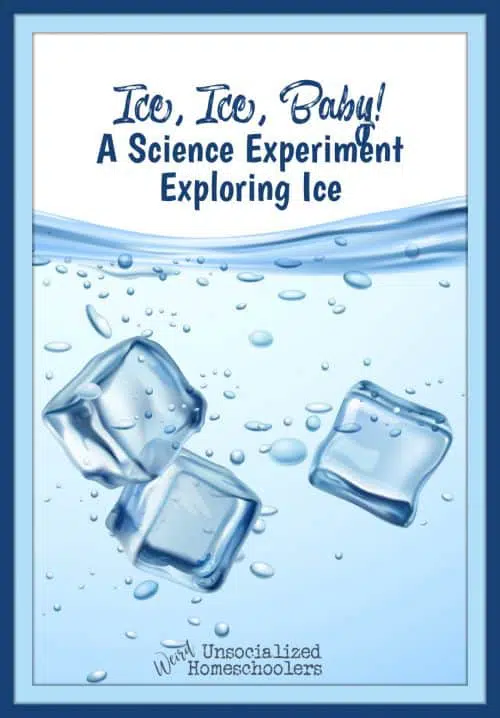Ice, Ice, Baby! A Science Experiment Exploring Ice
Ice, Ice, Baby! A Science Experiment Exploring Ice
I am going to reveal my age. Vanilla Ice, aka Robert Van Winkle, sang the song, *Ice, Ice, Baby during my high school years. It’s a catchy tune that was on the radio every 3 or 4 songs. Who knew what he really meant by the song but, hey, ice is cool. (Haha, see what I did there?) *If you want to show this YouTube video to your children, please watch it first to be sure it’s appropriate for them to view.
Some of you may live in an area that right now that has snow and ice. Some may not. Ice is fascinating because it is so simple. It is one of the most basic physical changes to a very basic chemical compound. Water is life. We need it to survive. It is 71% of the earth, 60% of the human body, and a focus of space exploration. Scientists, humanitarians, and organizations are devoted to finding sources of water.
Water is simple. Two atoms of hydrogen and one atom of oxygen – H2O. The water molecules dance around bumping into each other. The higher the temperature, the faster the dance. The lower the temperature, the slower the dance.
So, what is an easy experiment we can do with water and a freezer? Make ice, of course!
Today we are going to freeze both cold and hot water to see which freezes first. This is a study of a physical change. We are turning a liquid into a solid. We are not changing the chemical makeup of water but just its physical state. It is still H2O. If you let the ice melt, it is still H2O. It is never not H2O.
What You Need and How to Do It
You will need two small containers, water, a freezer, food coloring, and a way to heat water. Measure 25ml of cold water and 25 ml of hot water. I measured 25 ml of water into a container and put it in the microwave for 20 seconds to heat the water. I added one drop of red food coloring so we knew this was the warm water. I measured 25 ml of cold water into a container and left it natural (no food coloring). I put both in the freezer and set a timer. We checked the containers every hour. At hour 3, the cold water was still not frozen solid but the hot water was frozen solid. What????
Was there some witchcraft at work? It was the same water. Why was the result different?
The rate at which the hot water and cold water freeze is different because the cold water molecules are moving around more slowly, so it takes the cold water molecules longer to find a friend and bond. Because the hot water molecules are speeding around and bumping into other water molecules, they can find and bond with each other more quickly. It’s the difference between a slow dance and a mosh pit.
Diving Deeper
Now if you want to get a little deeper into it, let’s add a chemical to the mix. Hydrogen peroxide – H2O2 – has an extra oxygen atom. It is stored in a brown bottle to keep sunlight from degrading it and stealing the extra oxygen atom. I added 25 ml of H2O2 to a container and dyed it green (this is for reference and safety purposes). I checked it at the same intervals as the water. It did freeze, but you can see the structure of “freezing” is different to the eye. The water has large clear parts. The H2O2 does not. You can see different crystals, and you can see that the texture is almost like a slushy.
Take the containers out of the freezer and set them on the counter for 30 minutes. You’ll see that the ice with nothing added will melt. You will have water and still have a solid piece of ice. H2O2 (the ice with hydrogen peroxide added) will act very differently. It will never be a solid mass with water around it. It will be slushy. You can’t break through the H2O (plain water) with your finger, but you can break through the H2O2 with your finger since it’s slushy.
This is a fun, easy, and cheap science learning activity. You already have everything you need.
Remember
Also, remember “Yo, if you’ve got a problem, I’ll solve it”. Yes, Water, you can! Hydration, ice for an injury, etc.
***Vanilla Ice isn’t a doctor and neither am I, so our advice isn’t medical advice. It’s just for fun and is an awesome song!***
Jaime Lester Green is a wife and homeschool mom of 2 amazing children–a high school senior and an 8th grader. Loves all things science, is a NASA nerd and space geek, is addicted to crafting, and has way too many books (mostly crime novels and – you guessed it- science and space related).




